AZoBuild spoke with Kristian Ahlmark from Schmidt Hammer Lassen Architects about their ambitious new project Rocket&Tigerli, which will become the world’s tallest residential building with a wooden load-bearing structure.
Please could you introduce yourself, your background, and how you came to be involved in architecture?
My name is Kristan Ahlmark. I work as Design Director and Partner in Schmidt Hammer Lassen Architects (SHL) at our studio in Copenhagen.
I was born in Aalborg in Northern Jutland and have lived in many different parts of Denmark; however, I have lived the majority of my life in Copenhagen. I got my architecture degree at the Royal Danish Academy in Copenhagen. The reason why I chose architecture as a profession cannot be pinned down to one thing. For me it was not a revelation, I did not wake up one morning and decide to become an architect - rather, it came bit by bit, perhaps as a result of my upbringing.
I spent part of my childhood growing up in one of Denmark's first cooperative housing communities. Everyone had their own small private home with access to communal eating, common rooms, common outdoor areas, farm animals, a football field, basketball, etc. It was a way of life with a certain set of values attached to it and based on a sharing economy as a guiding principle for architecture planning. In addition to this, I have lived in many other places where I was exposed to vernacular architecture, and I think that was also where I started to pick up on different architectural styles and ways of living depending on the landscape, the weather conditions, and culture.
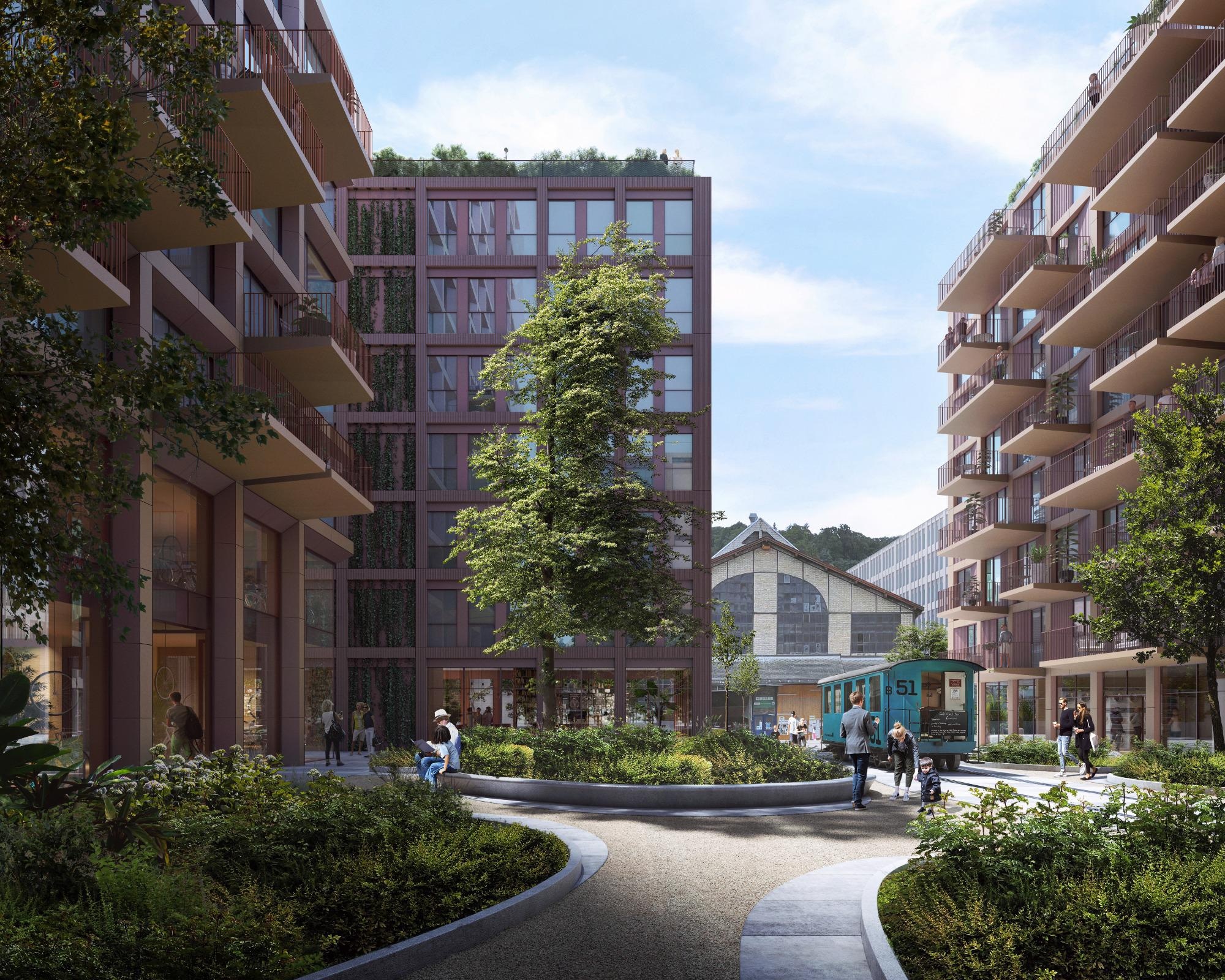
Image Credit: Schmidt Hammer Lassen Architects
Whereas my parents worked as a journalist and as a primary school teacher, respectively, my grandfather too was an architect and my uncle worked as a construction architect. Where the inspiration from my grandfather and uncle is pretty straightforward, I think my parents and my upbringing helped sprout interest in how we shape societies and, conversely, how we are shaped by the societies we live in.
All of this, my upbringing, the moving around, my parents, etc. - the things I have been exposed to in my childhood and youth have definitely pushed me towards the field of architecture as a framework for how we manage our daily lives, and towards an understanding of architecture as highly contextual - an understanding I share with the rest of the SHL studio, and which naturally permeates through the way we work.
Your building design Rocket&Tigerli has won an international competition to become the world’s tallest residential building with a wooden load-bearing structure. What inspired Schmidt Hammer Lassen to embark on such an ambitious design?
The ambition to build the world's tallest timber residential building comes from the client, lmplenia/lna Invest AG. We participated in the competition because we really wanted to realize this amazing project, which, in our opinion, pushes a highly relevant sustainable agenda - an agenda that spoke to our heartfelt love of creating high-quality architecture and buildings in wood.
At SHL, we are deeply embedded in the Nordic architecture tradition that has always favored wood as a building material. Thus, we came with the experience, know-how, and passion that a project of this scale and ambition demands. For us, it was never about designing the world's tallest residential timber building, but about our interest in creating quantum leaps that will help push a green transition in the built environment, seeing that the building industry, in our part of the world, counts for 40% of all carbon emissions.
So, for us, the Rocket&Tigerli project posed an extraordinary possibility to have an impact on the development of a more sustainable future. Like in all of our projects, it is always about pushing a green agenda, taking it to new heights, so to speak. The Rocket&Tigerli project challenges the limits of what we have been able to do earlier on and hopefully, this will attract attention in a relatively conservative building industry.
What is the inspiration behind the name of this project?
The upcoming Rocket&Tigerli neighborhood is located in Lokstadt - a former industrial area in Winterthur known for its production of locomotives. Thus, the name Rocket&Tigerli derives from the site's industrial heyday, referring to the locomotives named Rocket and Tigerli.
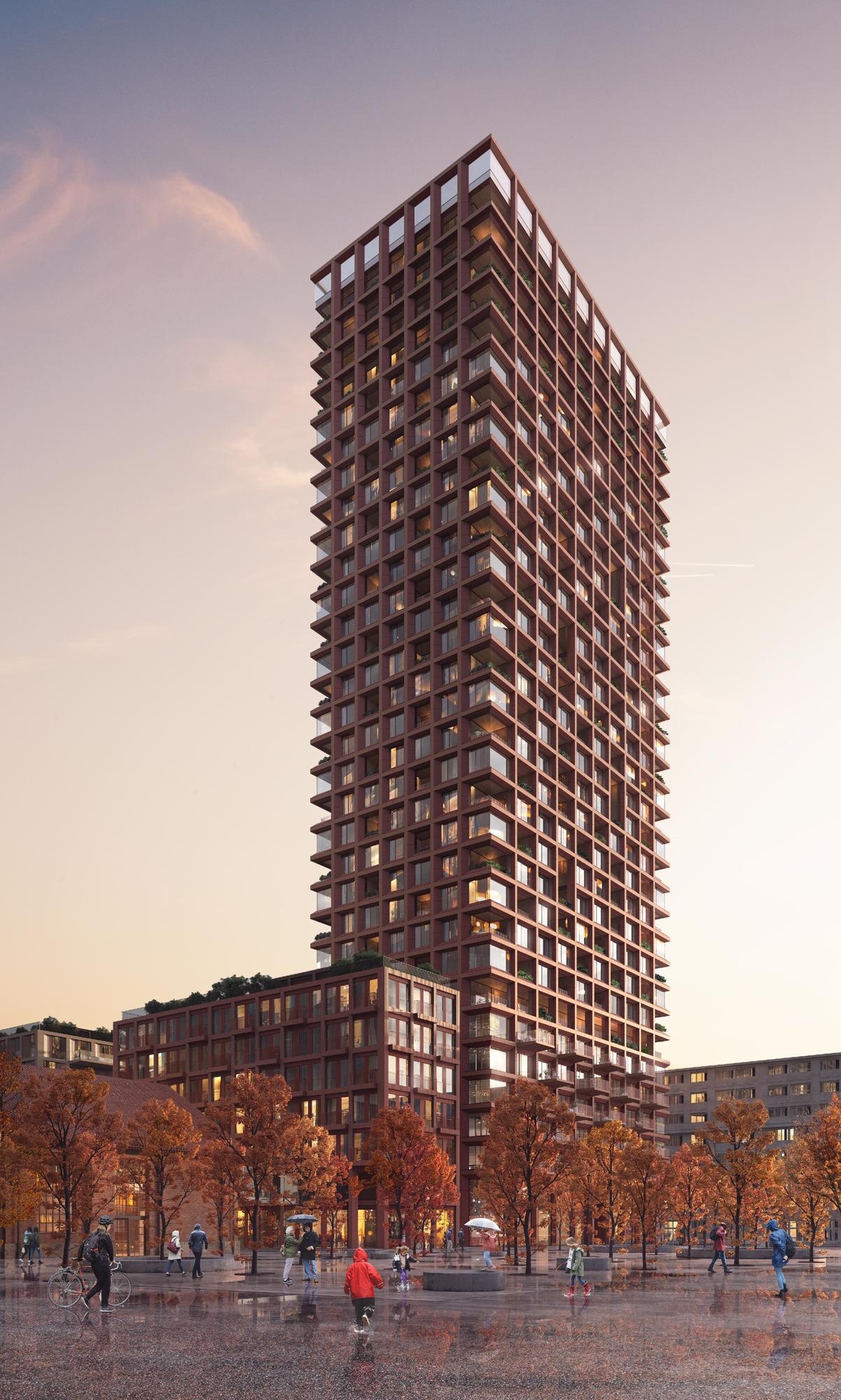
Image Credit: Schmidt Hammer Lassen Architects
Today, the Lokstadt area is still characterized by industrial buildings that have been maintained, adding cultural and historical layers to the site. The post-industrial grit of buildings showcases an enormous level of detail and high quality in construction and material choices, as they were once the cathedrals of their time.
When the Church held the power, and thus the money, impressive cathedrals were built all over. By the time the industrial development gathered speed, and the money had shifted hands, the factories became the cathedrals of their time, expressing the value created by the industrial companies. Because of their high quality and attention to detail, they have an embedded strength in the sense that they can be transformed and revitalized for new purposes. Their generous constructions enable us to take out the content and replace it with something new, while at the same time maintaining aesthetic value and historical and cultural layers.
When the Lokstadt area was first developed it marked a milestone in industrialization; today, the transformation of this area and the development of the Rocket&Tigerli neighborhood induces a large step toward a more sustainable urban development paradigm. Rocket&Tigerli is a frontrunner, and the name is a homage to the area's history.
How will this new building complement the nature of the district?
The Lokstadt area is characterized by its rich materiality and level of detail that goes back to the time when it was built. Now that the industry has been phased out, making space for people to move in, our job is to revitalize the area by conveying its history and creating new connections and spaces.
At SHL, we are very much driven by site context - the physical as well as the psychological and sociological. In the Rocket&Tigerli project, our focus has been on creating architecture that, in some way, paves the way for interaction and sets the scene in relation to the scale of this former industrial site.
The materiality and color gamut of the tower is in harmony with the surrounding environment - the red and yellow terracotta, the green mesh, etc.
The building will be made up of four separate structures. Why was the decision made to create this split?
The original masterplan for the Rocket&Tigerli site dictated one closed block with a tower atop, but relatively early in the process, we decided to challenge this idea for multiple reasons. First of all, we wanted to create high-quality apartments with maximum daylight inflow. The depth of the original closed block structure and the disposition of the corner apartments made it difficult to obtain the living quality that we wanted in relation to access to daylight. By fractionating the block into an open structure, most of the apartments will now have an inflow of daylight from two sides (dual aspect).
In addition to this, we also considered the block as part of the city's spatial hierarchy. The open block structure will help soften the transitions between significant plazas and urban spaces in the area, and opening the block is part of our ambition to invite not just future residents, but the general public to stroll through and use the courtyard as a place for social and recreational activities.
Thus, we try and integrate the surrounding urban structures into the space by creating physical and visual connections to the existing buildings, such as the gable of a nearby production center. Ultimately, what you get is a block structure with a much higher degree of permeability at the ground floor level, where we have also placed all public functions to further support a vibrant and thriving neighborhood.
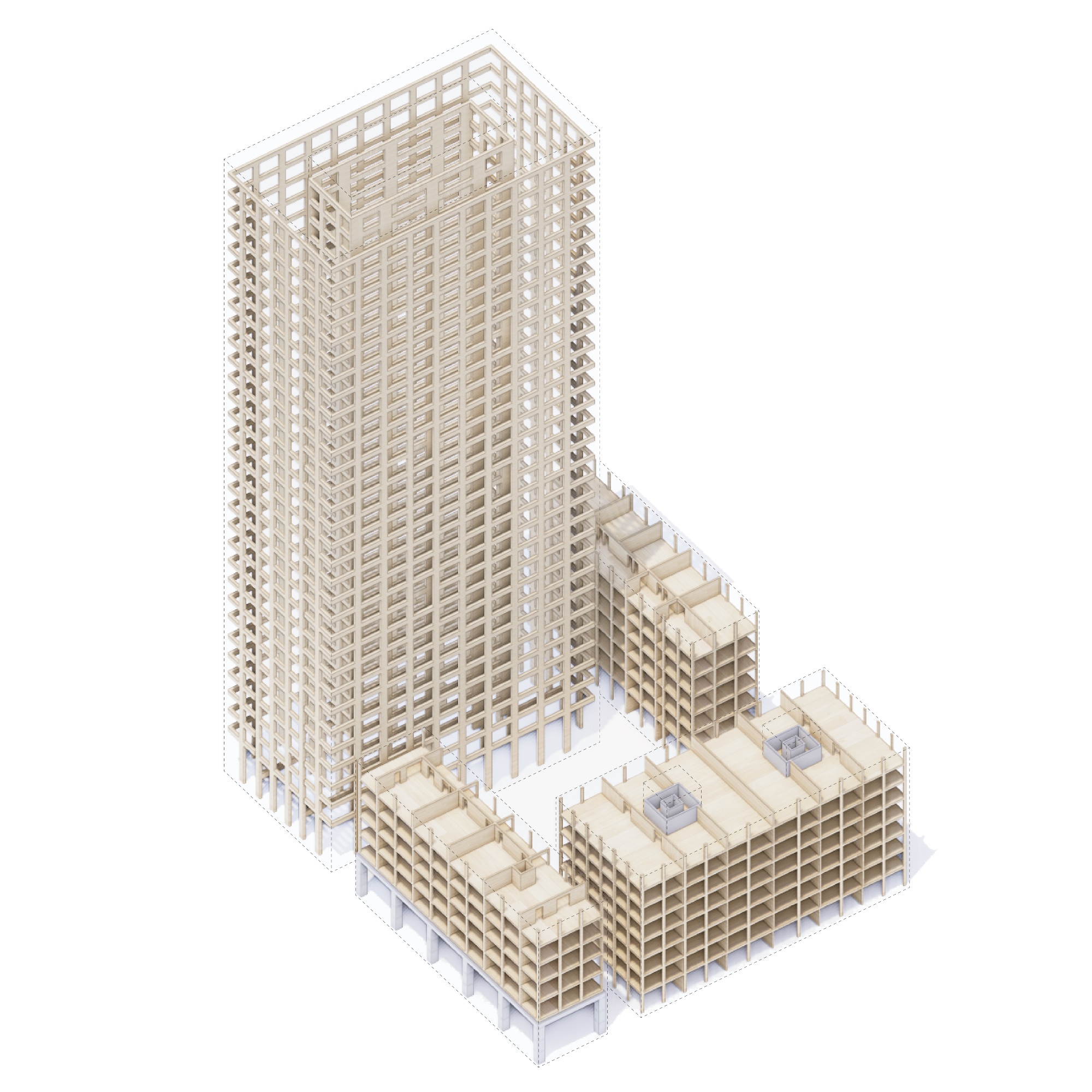
Image Credit: Schmidt Hammer Lassen Architects
Finally, it was important to us that the project was not simply reduced to the Rocket&Tigerli - that is, a dominating tower and then a diffuse base, where functions were harder to decode. We saw great potential in creating a distinctive identity for each building making up the block structure so that the residents living there get a strong sense of belonging, a sense of "this is my house, this is the neighborhood I live in, this is the city it is a part of".
In order to identify oneself with a place and create an emotional bond that makes you feel truly at home, it is essential to be able to orientate oneself, and therefore we have made it easy to decode the different functions - the hotel, the cooperative housing, the student housing, the condominiums, by giving each building its own visual expression.
Could you please describe the visual design of the buildings, both in terms of the exterior façade and the interior residential and commercial spaces?
In the exterior parts of the buildings, we have worked with a unitized facade system that secures easy and quick mounting. We have angled it to honor the structural system, meaning that instead of trying to camouflage that this is in fact a timber frame building with a clear definition of pillars and beams, we wanted to celebrate this amazing construction by exposing what is behind the facade.
In addition to this, the slight angling of the facade module means that the otherwise relatively stodgy building system we use, whenever we build in wood, obtains a slimmer and more light expression. We have also used terracotta slabs to create a tactile and material connection to the surrounding area.
As for the interior, we are still in the process of fully developing the concept, but our goal is to have as many exposed surfaces as possible - the ceilings and parts of the load-bearing system - so residents actually get a feeling of living inside the timber frame system. From a sustainable perspective, this also makes good sense because we do not need to further "clad" the apartments on the inside, as you usually do. Thus, we not only save materials and time but also energy and money.
Why has load-bearing with timber been a limited technique before now in such large buildings? How will your building be different from those that have come before in this regard?
It clearly has to do with tradition and technique. During the post-war era, the predominant construction technique was to build in concrete and steel. It was part of a streamlining process, which made perfect sense because we needed to re-build cities all over Europe, so being able to cast concrete on-site and prefabricate building components was a way of speeding up the process. Also, wood has been considered a fire risk because we used to use wood that was too dry, and we used to build in ways where the wood would be over-exposed, so naturally, we were looking for safer alternatives.
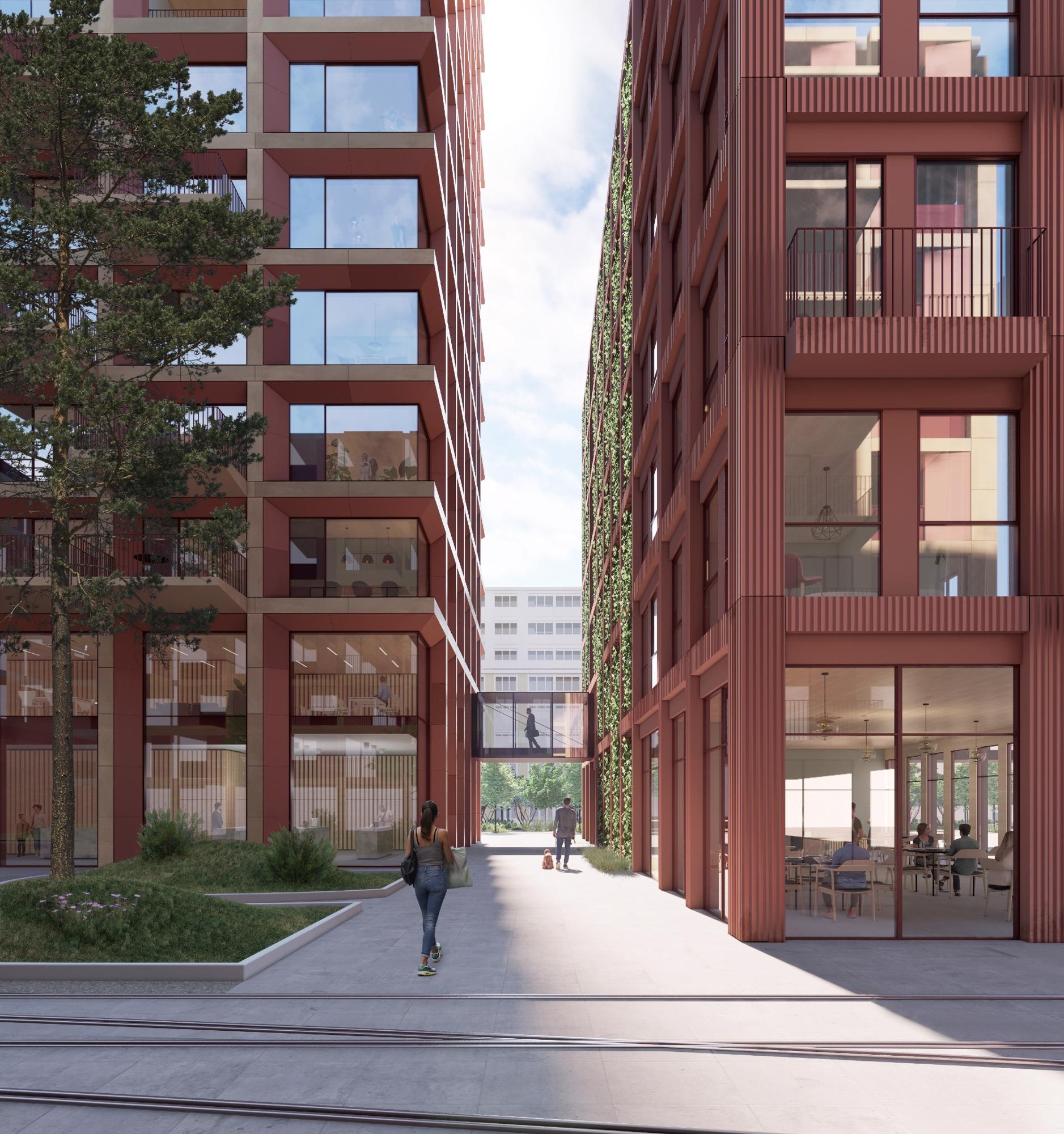
Image Credit: Schmidt Hammer Lassen Architects
But with a growing concern for the climate crisis and pressure for a green transition within the industry, we are starting to see a paradigm shift. Wood as a building material is experiencing a renaissance because of its obvious advantages when it comes to sustainability. However, the building industry is conservative, and if we really want to push the green agenda, we need to demand that manufacturers look into new materials and construction methods, and that clients be willing to take risks.
Wood is not a new material, we have been using it forever, so we already have a lot of experience with building with it and we know much about its technical and static capacities. But for a project of a scale like the Rocket&Tigerli, obviously, we need to build up new experience - that is always the great challenge about being first movers. We know that it is possible because we have tested it, but now we need to test it in real life, just like we did when we started using structural concrete.
However, the experience we have today from building with modular concrete systems can more or less be transferred 1:1 to wood constructions, and we now consider wood as a modular building material that can be taken apart and reused in other constellations.
The way forward is for our industry to reflect on how we build, and how to keep pushing the green transition as much as possible. We have already seen a lot of quantum leaps, so it is possible to re-think the way we do things as architects, and as a whole industry.
What effect will the use of this amount of wood have on the carbon footprint of this structure?
We do these calculations on an ongoing basis, and the tentative calculations show that the building's carbon footprint will be minimized by 30-40%.
What is the timeline for this project? When will the building be completed and open to residents?
We are already doing the preliminary examinations and we will start the project in the early autumn, expecting the residents to be able to move in by 2026.
Which parts of this project do you personally believe are the most exciting/significant?
The height of the construction, without any doubt, To build something of this scale in wood with a tube-in-tube system is super exciting and something I, or the studio for that matter, have never tried before. The tubes comprise the load-bearing and stabilizing system, not the cores. In addition to this, the flexibility embedded in the project means that the building can be transformed and adapted to future needs.
We have placed the cores strategically to make the building flexible; for instance, the lower levels are now going to house a hotel, which was not part of the original plan. Also, the ambition to create high-quality housing, working with both dual aspect and dual complex apartments, has been a driver for us in the project and we are very excited to further explore this.
How important is it that the architectural field implements more innovative sustainable building strategies like this in the future?
This is super important, and a must for our profession that we help optimize the way that we build or the way that we transform our built environment. At SHL, we have a lot of projects where we work with the possibility of transformation rather than building new. This is something which we have always done to a great extent.
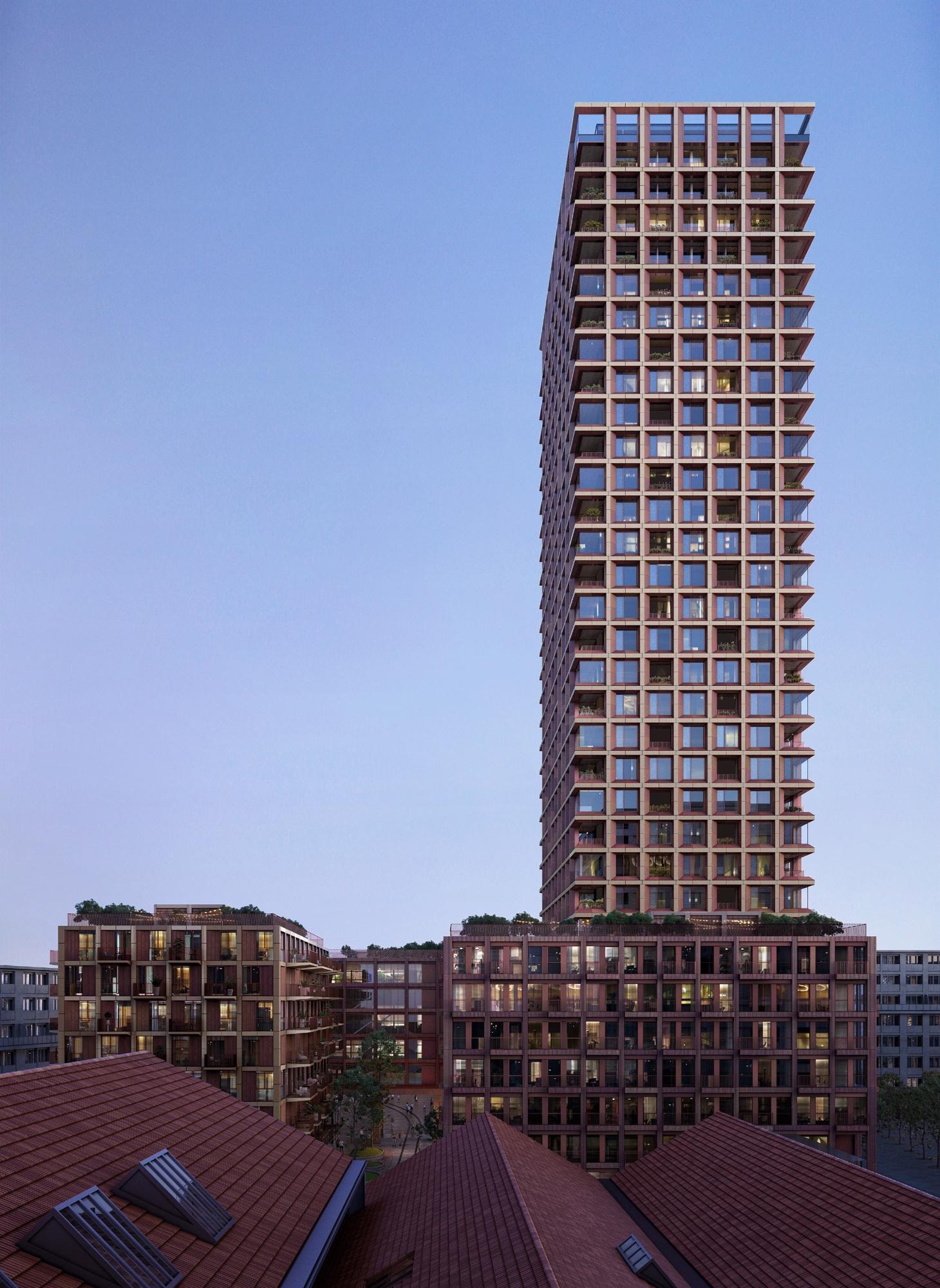
Image Credit: Schmidt Hammer Lassen Architects
It is implicit that good architecture is sustainable architecture. Good architecture is not just knocked down and replaced with something new; rather, it is transformable and reusable, and this is of course an important aspect of sustainability - that a building will last as long as possible, or alternatively, that it can be transformed, taken apart, and used in a new context.
Is Schmidt Hammer Lassen working on any other projects with a sustainable focus?
Everything we do is sustainable to some degree - it is a part of the way that we work, and we have developed a sustainability tool that maps the potential challenges and blind spots of a brief, helping both us and the client to come up with a sustainable vision at the early stages of a project.
This is a fully integrated process in our practice that every project is subjected to, as we know that the sustainable solutions need to be implemented from the beginning, and not just be something we sprinkle in the project at the end. The mapping tool ensures that we explore every nook and cranny of a brief to come up with a tailored solution for the project.
Where can readers find out more about Schmidt Hammer Lassen?
Selected Projects:
Mixed-use and adaptive transformation project by the waterfront/Toronto, Canada/ 130,000 m2 /1st prize in international competition 2019, Partner, Design Director. The waterfront in Toronto is undergoing a transformation from a former industrial site to become an integrated part of Toronto offering a mix of uses, including residential, cultural, public functions, etc.
Mixed-use project adapting and future-proofing a unique heritage site/Boston, USN 88,672 m2/ Completion expected in 2024/ 1st prize in international competition, 201 7/ Partner, Design Director.
The Seaport World Trade Center will bring together a wide range of functions in a highly exposed location in one of Boston's most central growing urban locations. Interweaving building with landscape architecture, a place in town is created with completely new amenity values, providing a new destination, not only for the main users of the building but also for the people of Boston.
Mixed-use complex with enhanced integration between building and city via new passages and squares/Oslo, NO/ 58,500 m2/ Completed in 2021/ 1st prize in invited international competition, 2014/ Partner, Design Director.
VIA is a central cross-section and a symbolic focal point for the new modern Oslo. The architecture interprets the surrounding volumes' characteristics and heights and adds a new and unique architectural expression. The complex is a combination of exclusive shops, high-end offices, and parking facilities available in the city center, ensuring a lively urban environment.
- Utrecht University of Applied Sciences
New build gathering the daily activities of ca. 6,000 students attending several previously scattered educational institutions/ Utrecht, NL/ 22,500 m2/ Completed in 2018/ 1st prize in international competition, 2015/ Partner, Design Director.
The new educational facility for the Utrecht University of Applied Sciences houses seven institutes as well as university facili ties located on the campus, being the closing piece of major additions and changes to the campus, showcasing contemporary and future-proof educational facilities by some of Europe's best-known architects.
Unified concert, congress, and hotel complex in one architectonic sculpture with publicly accessible ground floor/Malmo, SE/ 54,000 m2/ Completed in 2015/ 1st prize in developer competition 2010/ Partner, Design Director.
The new mixed-use, conference and hotel complex is situated on Universitetsholmen in Malmo. The ground floor is fully accessible to the public allowing people to pass through the building whether going to a concert, conference, coffee shop, restaurant, or just taking a shortcut.
About Kristian Ahlmark
 Kristian Lars Ahlmark joined Schmidt Hammer Lassen in 2001 and his great technical skill and strategic vision were clear from the start. He quickly rose to become a member of the partner group, and since then has been instrumental in catapulting the firm beyond Scandinavia and into markets including the United State and China. Kristian has been involved in every phase and function of the architectural process, from visualization and sketching to realization. With a vast portfolio of projects that range from Detroit to Beijing, and across typologies and scales, they all share Schmidt Hammer Lassen’s unmistakable Scandinavian design values. Kristian’s creative energy permeates the firm, and the numerous award-winning projects he has designed. He is a sought-after lecturer, having presented on a variety of topics spanning the architectural process at universities, conferences, and organizations worldwide.
Kristian Lars Ahlmark joined Schmidt Hammer Lassen in 2001 and his great technical skill and strategic vision were clear from the start. He quickly rose to become a member of the partner group, and since then has been instrumental in catapulting the firm beyond Scandinavia and into markets including the United State and China. Kristian has been involved in every phase and function of the architectural process, from visualization and sketching to realization. With a vast portfolio of projects that range from Detroit to Beijing, and across typologies and scales, they all share Schmidt Hammer Lassen’s unmistakable Scandinavian design values. Kristian’s creative energy permeates the firm, and the numerous award-winning projects he has designed. He is a sought-after lecturer, having presented on a variety of topics spanning the architectural process at universities, conferences, and organizations worldwide.
Disclaimer: The views expressed here are those of the interviewee and do not necessarily represent the views of AZoM.com Limited (T/A) AZoNetwork, the owner and operator of this website. This disclaimer forms part of the Terms and Conditions of use of this website.